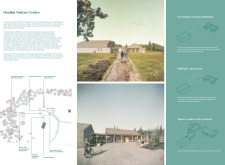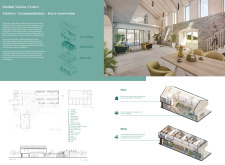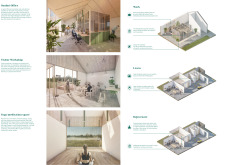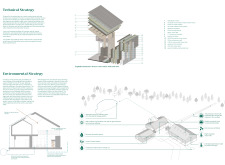5 key facts about this project
The Ozolini Visitor Centre is located in the beautiful rural area of Latvia, surrounded by forests and lakes that enhance the visitor experience. It aims to connect people with nature, serving as a retreat for relaxation and education. The design is influenced by traditional Latvian farmsteads, which consist of smaller, interconnected buildings. This layout encourages social interactions while allowing each space to maintain its distinct character.
Design Elements
The centre includes key design features, such as an existing pond that has been turned into an attenuation reservoir. This adaptation not only improves the site's appearance but also helps manage water naturally. Communal areas, especially the shared courtyards, foster connections among visitors and provide spaces for group activities.
Architectural Layout
The layout thoughtfully combines indoor and outdoor experiences. Paths wind through the nearby forest, leading visitors to a serene lake, promoting a sense of exploration and discovery. Inside, there are workshops and activity spaces designed to inform guests about local plants and traditional tea-making, thereby enhancing the cultural aspect of the area.
Sustainability Features
Sustainability plays a significant role in the design of the Ozolini Visitor Centre. The project retains old stone walls that are waterproofed for longevity. New building envelopes improve both energy efficiency and comfort. Quiet spaces allow visitors to relax, and systems for rainwater harvesting and greywater reuse show a commitment to sustainable water practices.
Technical Considerations
The barn features an insulated envelope that maintains comfortable indoor temperatures while utilizing the warmth of exposed stone walls. This design promotes energy efficiency. Smaller buildings employ a glulam timber frame, providing structural support and allowing for open, adaptable interior spaces.
The overall design balances traditional influences with modern techniques, creating a harmonious relationship between the buildings and their natural surroundings. Each element contributes to a cohesive environment that invites visitors to engage with both the architecture and the landscape.






















































